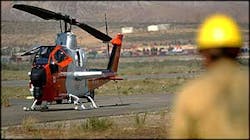Infrared Equiped Copters Help California Firefighters See Through Smoke
Two AH-1 Cobra helicopters that the U.S. Forest Service rescued from the scrap heap have found new use as aerial firefighting tools.
Equipped with infrared cameras, the choppers have been used by firefighters battling the Sawtooth and Millard fires to get an eagle's-eye view of the flames when thick smoke obscured the paths of the wildfires.
The U.S. Forest Service's Firewatch Cobras were not the only new toys to take to the skies during the effort to fight the massive blazes. For the first time, a modified DC-10 jet called the 10 Tanker Air Carrier saw service in a wildfire as an air tanker. State firefighters are still evaluating the DC-10's effectiveness, but they like what they saw.
"Just to kind of sum it up, it performed as advertised and better," said Mike Padilla, an aviation chief with the California Department of Forestry and Fire Protection.
By Tuesday, the Sawtooth Complex Fire near Yucca Valley was fully contained, and firefighters had more than half of the Millard Complex fire in the San Gorgonio Wilderness contained. Aircraft such as the Cobras and 10 Tanker have been an important part of the firefighting effort, but those who wear the flight suits said they don't deserve the lion's share of credit.
"What puts the fires out is ground troops, but I love the stuff we got," said Tony Duprey, an air tactical group supervisor who rode the gunner's seat in one of the Cobras assigned to the fires.
"The hotshots see more fire than anybody," said Duprey, a former hotshot himself. Hotshots are firefighters who are dispatched to the fire lines with chain saws and other hand tools to clear away vegetation before it fuels a wildfire.
Tanker pilot Skip Alderson agreed. He said his silver and red Lockheed Neptune tanker can aid firefighters on the lines by slowing the spread of flames, but major fires can't be stopped by air power alone.
"We're a tool in their fire bag," he said.
The special DC-10 took off from Victorville on Sunday and dropped two loads of fire retardant south of Onyx Summit. The aircraft, which costs about $52,000 a day to fly, can carry about 12,000 gallons of fire retardant. Padilla said the jet's two runs were about as effective as 18 drops from the department's propeller-powered
ST-2 Airtankers, which can carry about one-tenth as much fire retardant as the DC-10.
The venomous-looking Cobra helicopters were designed to wreak havoc over enemy troops in a war zone.
Duprey and Steve Jensen were assigned to a helicopter painted orange and white instead of military green, but the aircraft still carries signs of its warrior past. Controls that Duprey can use to fly the helicopter if Jensen's controls malfunction still have markings that show which buttons were once used to fire weapons. But instead of missiles, the Cobras are equipped with Forward Looking Infrared and video cameras that can beam a real-time image of a fire to a satellite and back down to a command center. And as far as Duprey is concerned, they're a blast to ride in.
"I'm having a ball," he said. "Obviously, most firefighters are adrenaline junkies."
U.S. Forest Service regional aviation officer Dennis Hulbert said that at one point during the battle against the fires, the Cobra's infrared technology, which can look through a smoke column to show flames' location, was vital. The blaze jumped a canyon, and knowing where the fire was made it possible for fire commanders to order firefighters out of the danger zone.
This is the first year the Forest Service has used the Cobras, Hulbert said. Before the Forest Service found them, they were scheduled to be crushed into scrap. Hulbert sees a larger role for the aircraft than the one they filled above the Sawtooth and Millard fires. He wants individual firefighters to be able to receive a real-time overhead view of the flames when they role out to a wildfire.
"My long-term goal is to have every firefighter be able to see it on his Palm Pilot," he said.
Republished with permission of the San Berardino County Sun.
